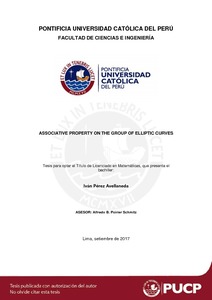| dc.contributor.advisor | Poirier Schmitz, Alfredo B. | es_ES |
| dc.contributor.author | Pérez Avellaneda, Iván | es_ES |
| dc.date.accessioned | 2017-11-08T22:55:10Z | es_ES |
| dc.date.available | 2017-11-08T22:55:10Z | es_ES |
| dc.date.created | 2017 | es_ES |
| dc.date.issued | 2017-11-08 | es_ES |
| dc.identifier.uri | http://hdl.handle.net/20.500.12404/9696 | |
| dc.description.abstract | La conjetura de Fermat fue uno de los acertijos matemáticos más misteriosos hasta 1995. El problema fue formulado en 1637 por Pierre de Fermat. Él afirmó saber cómo resolverlo, sin embargo, no podía mostrar la prueba debido
a que el espacio en el margen de su copia de Arithmetica de Diofanto era insuficiente. Desde entonces mucho misticismo rodeó a la conjetura.
Mientras tanto, independientemente, nuevas ramas de las matemáticas se desarrollaban. La geometría algebraica y el análisis complejo permitieron a
Andrew Wiles resolver finalmente la conjetura. La solución involucra, entre otras herramientas, el uso de curvas elípticas. Esto es suficiente motivo para estudiarlas.
En líneas generales las curvas elípticas son polinomios cúbicos no singulares en dos variables con un punto especial de coordenadas racionales en los que podemos establecer una estructura de grupo. Para manipular las operaciones cómodamente transformamos la ecuación de la curva elíptica en una más apropiada con menos términos. Para lograr esto exploramos los aspectos fundamentales de los espacios proyectivos que facilitarían la transición.
Como ya es conocido, existen casos en las matemáticas en los que hay un intercambio entre simpleza y elegancia. Uno debe profundizar un poco para alcanzar la estética. Nuestro objetivo es probar la propiedad de asociatividad del grupo en las curvas elípticas por medio del grupo de Picard de una variedad algebraica asociada. Esto provee una prueba alternativa de dicha propiedad y reemplaza los cálculos engorrosos de la prueba directa que usa solo la definición de la operación del grupo. Para lograr esto desarrollamos la teoría de divisores. Esto nos conduce al estudio de funciones racionales sobre las curvas y de este modo nos enfrentamos a uno de los resultados más importantes de la geometría algebraica: el teorema de Riemann-Roch. Basados en esto probamos que las curvas elípticas sobre los cuerpos de característica cero tienen genero uno.
Finalmente definimos el grupo de Picard. Este grupo mide el grado de cuánto del conjunto de divisores no tiene origen en las funciones racionales.
Luego establecemos un homomorfismo entre este grupo y la curva elíptica:
esta es en una manera elaborada de afirmar que la asociatividad de una estructura se preserva en la otra. | es_ES |
| dc.description.abstract | The Fermat conjecture was one of the most mysterious puzzles of mathematics until 1995. The problem was formulated in 1637 by Pierre de Fermat.
He claimed that he knew how to solve it, but was however unable to exhibit the proof because of the lack of space on the margin of his copy of Diophantus's
Arithmetica. Since then a lot of mysticism surrounded the conjecture.
Meanwhile, independently, new branches of mathematics were developed.
Algebraic geometry and complex analysis allowed Andrew Wiles to finally solve the conjecture. The solution involves, among other tools, the use of elliptic curves. That is enough reason for their study.
Roughly speaking elliptic curves are non-singular cubic polynomials in two variables with a special point of rational coordinates where a group structure can be set. In order to handle computations comfortably we transform the equation of the elliptic curve into an appropriate one with fewer terms. To achieve this goal we explore fundamental aspects of projective spaces which facilitate the transition.
As it is known, in some cases there is a trade-o_ in mathematics between simplicity and elegance. One must dig a little deep to reach aesthetics. We aim to prove the associativity law of the group on elliptic curves by means of the Picard group of an associated algebraic variety. This provides an alternative proof of the property and replaces the usual burdensome computations of the straight proof by definition of the group operation. In order to achieve this, we develop the theory of divisors. This leads us to the study of rational functions on curves, and thus face one of the crucial results of algebraic geometry: the Riemann-Roch theorem. Based on this we prove that elliptic curves over fields of characteristic zero have genus one.
Finally we define the Picard group. This group measures the extent of how much of the set of divisors fails to have its origin on rational functions.
Then we establish a homomorphism between this group and the elliptic curve: this yields a fancy way of saying that associativy of one structure is preserved in the other. | es_ES |
| dc.language.iso | eng | es_ES |
| dc.publisher | Pontificia Universidad Católica del Perú | es_ES |
| dc.rights | info:eu-repo/semantics/openAccess | es_ES |
| dc.rights.uri | http://creativecommons.org/licenses/by-nc-nd/2.5/pe/ | * |
| dc.subject | Curvas elíipticas | es_ES |
| dc.subject | Geometría algebraica | es_ES |
| dc.subject | Conjetura de Fermat | es_ES |
| dc.title | Associative property on the group of elliptic curves | es_ES |
| dc.type | info:eu-repo/semantics/bachelorThesis | es_ES |
| thesis.degree.name | Licenciado en Matemáticas | es_ES |
| thesis.degree.level | Título Profesional | es_ES |
| thesis.degree.grantor | Pontificia Universidad Católica del Perú. Facultad de Ciencias e Ingeniería | es_ES |
| thesis.degree.discipline | Matemáticas | es_ES |
| renati.discipline | 541026 | es_ES |
| renati.level | https://purl.org/pe-repo/renati/level#tituloProfesional | es_ES |
| renati.type | https://purl.org/pe-repo/renati/type#tesis | es_ES |
| dc.publisher.country | PE | es_ES |
| dc.subject.ocde | https://purl.org/pe-repo/ocde/ford#1.01.00 | es_ES |






